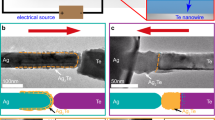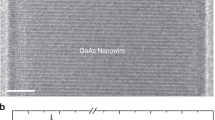Abstract
Controllable production of nanometre-sized structures is an important field of research, and synthesis of one-dimensional objects, such as nanowires, is a rapidly expanding area with numerous applications, for example, in electronics, photonics, biology and medicine. Nanoscale electronic devices created inside nanowires, such as p–n junctions1, were reported ten years ago. More recently, hetero-structure devices with clear quantum-mechanical behaviour have been reported, for example the double-barrier resonant tunnelling diode2 and the single-electron transistor3. The generally accepted theory of semiconductor nanowire growth is the vapour–liquid–solid (VLS) growth mechanism4, based on growth from a liquid metal seed particle. In this letter we suggest the existence of a growth regime quite different from VLS. We show that this new growth regime is based on a solid-phase diffusion mechanism of a single component through a gold seed particle, as shown by in situ heating experiments of GaAs nanowires in a transmission electron microscope, and supported by highly resolved chemical analysis and finite element calculations of the mass transport and composition profiles.
This is a preview of subscription content, access via your institution
Access options
Subscribe to this journal
Receive 12 print issues and online access
$259.00 per year
only $21.58 per issue
Buy this article
- Purchase on Springer Link
- Instant access to full article PDF
Prices may be subject to local taxes which are calculated during checkout




Similar content being viewed by others
References
Haraguchi, K., Katsuyama, T., Hiruma, K. & Ogawa, K. GaAs p-n junction formed in quantum wire crystals. Appl. Phys. Lett. 60, 745–747 (1992).
Björk, M.T. et al. Nanowire resonant tunneling diodes. App. Phys. Lett. 81, 4458–4460 (2002).
Thelander, C. et al. Single-electron transistors in heterostructure nanowires. Appl. Phys. Lett. 83, 2052–2054 (2003).
Wagner, R.S. in Whisker Technology (ed. Levitt, A.P.) 47–119 (Wiley. New York, 1970)
Hiruma, K. et al. Growth and optical properties of nanometer-scale GaAs and InAs whiskers. J. Appl. Phys. 77, 447–462 (1995).
Duan, X. & Lieber, C.M. General synthesis of compound semiconductor nanowires. Adv. Mater. 12, 298–302 (2000).
Duan, X. & Lieber, C.M. Laser-assisted catalytic growth of single crystal GaN nanowires. J. Am. Chem. Soc. 122, 188–189 (2000).
Ohlsson, B.J. et al. Size-, shape-, and position-controlled GaAs nano-whiskers. Appl. Phys. Lett. 79, 3335–3337 (2001).
Kamins, T.I., Stanley Williams, R., Basile, D.P., Hesjedal, T. & Harris, J.S. Ti-catalyzed Si nanowires by chemical vapor deposition: Microscopy and growth mechanisms. J. Appl. Phys. 89, 1008–1016 (2001).
Ohlsson, B.J. et al. Growth and characterization of GaAs and InAs nano-whiskers and InAs/GaAs heterostructures. Physica E 13, 1126–1130 (2002).
Buffat, P. & Borel, J.-P. Size effect on the melting temperature of gold particles. Phys. Rev. A 13, 2287–2298 (1976).
Björk, M.T. et al. One-dimensional steeplechase for electrons realized. Nano Lett. 2, 87–89 (2002).
Gudiksen, M.S., Lauhon, L.J., Wang, J., Smith, D.S. & Lieber, C.M. Growth of nanowires superlattice structures for nanoscale photonics and electronics. Nature 415, 617–620 (2002).
Wu, Y., Fan, R. & Yang, P. Block-by-block growth of single-crystalline Si/SiGe superlattice nanowires. Nano Lett. 2, 83–86 (2002).
Baker, R.T.K. Catalytic growth of carbon filaments. Carbon 27, 315–323 (1989).
Helveg, S. et al. Atomic-scale imaging of carbon nanofibre growth. Nature 427, 426–429 (2004).
Massalski, T.B. (ed.) Binary Alloy Phase Diagrams 2nd edn Vol. 1 369–371 (ASM International, Materials Park, Ohio, 1990).
Gupta, R.P., Khokle, W.S., Wuerfl, J. & Hartnagel, H.L. Diffusion of gallium in thin gold films on GaAs. Thin Solid Films. 151, L121–L125 (1987).
Massalski, T.B. (ed.) Binary Alloy Phase Diagrams 1st edn Vol. 1 191–192 (ASM International, Metals Park, Ohio, 1986).
Magnusson, M.H., Deppert, K., Malm, J.-O., Bovin, J.-O. & Samuelson, L. Gold nanoparticles: production, reshaping, and thermal charging. J. Nanoparticle Res. 1, 243–251 (1999).
Bakkers, E. & Verheijen, M.A. Synthesis of InP nanotubes. J. Am. Chem. Soc. 125, 3440–3441 (2003).
Acknowledgements
This work was performed within the Nanometer Structure Consortium at Lund University, and supported by the Swedish Research Council (VR), the Swedish Foundation for Strategic Research (SSF), Office of Naval Research (ONR) and the Knut and Alice Wallenberg Foundation.
Author information
Authors and Affiliations
Corresponding author
Ethics declarations
Competing interests
The authors declare no competing financial interests.
Rights and permissions
About this article
Cite this article
Persson, A., Larsson, M., Stenström, S. et al. Solid-phase diffusion mechanism for GaAs nanowire growth. Nature Mater 3, 677–681 (2004). https://doi.org/10.1038/nmat1220
Received:
Accepted:
Published:
Issue Date:
DOI: https://doi.org/10.1038/nmat1220
This article is cited by
-
Towards 3D characterisation of site-controlled InGaAs pyramidal QDs at the nanoscale
Journal of Materials Science (2022)
-
Induced structural modifications in ZnS nanowires via physical state of catalyst: Highlights of 15R crystal phase
Nano Research (2022)
-
High-performance printed electronics based on inorganic semiconducting nano to chip scale structures
Nano Convergence (2020)
-
The compositional homogeneity of the metal particle during vapor–liquid–solid growth of nanowires
Scientific Reports (2020)
-
In situ analysis of catalyst composition during gold catalyzed GaAs nanowire growth
Nature Communications (2019)



